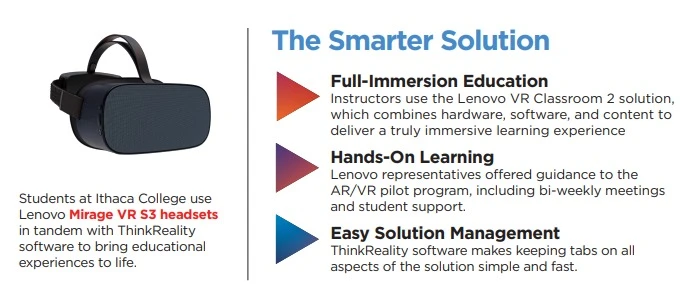Smarter enhances learning with virtual reality
Founded in 1892, Ithaca College is a private liberal arts college set on a 757-acre campus in Ithaca, New York. The college has a total enrollment of 5,000 undergraduates and 400 postgraduates.
Tomorrow’s learning technology
Ithaca College prides itself on mixing creativity with the latest advances. Early in 2018, the college started exploring additional opportunities around both augmented reality (AR) and virtual reality (VR), and how it could integrate those experiences with traditional teaching.
The college’s Education Department, which offers undergraduate and graduate programs for students interested in pursuing careers in teaching, quickly recognized the potential of AR and VR to improve learning outcomes.
Becky Lane, PhD, Associate Director Learning & Innovative Technology at Ithaca College, says: “We’re training the teachers of the future. They can be the leaders and bring AR and VR into the education, and we wanted to give them the grounding. Our aim is to instruct students how to use AR and VR effectively; we believe it will become a necessity in the years to come.”
A comprehensive tool to support studies
Ithaca College’s first ventures into VR worked well for staff and students learning how to create new experiences, but the project struggled with device and software management. As part of its program research, the college discovered ThinkReality, and contacted Lenovo to learn more.
At an early stage, Ithaca College chose to build its VR and AR in Education program based on the Lenovo VR Classroom 2 solution, which combines hardware, software, and content to deliver a truly immersive learning experience.
The Lenovo Mirage VR S3 headsets provide full integration with immersive digital learning solutions such as Uptale, Mozilla Hubs, and Veative, helping students and staff to understand how to use the technology, and how to integrate AR and VR into teaching and learning. The college also uses LanSchool Air management software to launch VR experiences on the headsets.
Becky Lane says: “Many school districts get grants and funding for AR/VR headsets, but they just sit in the box collecting dust because they don’t know how to use the technology or how to integrate it into lessons. With support from Lenovo and with excellent training on how to get the best out of the Mirage VR S3 headsets, we are able to bring our VR projects to life.”
From classroom to wilderness
To help kick-start the program, Lenovo assigned two employees with expertise in AR/VR to work with staff and students at Ithaca College, arranging one-on-one meetings to discuss objectives. Outcomes included creating 360-degree videos, creating an AR/VR experience for lessons, and finding new ways to distribute existing content.
Becky Lane comments: “Lenovo assigned Brian Moynihan and Shayla Rexrode to guide the pilot. We’ve had bi-weekly meetings to keep us all on the same page and to give feedback on the VR solution. Brian and I have presented at several conferences on the pilot, and Shayla and Brian have arranged lectures from UpTale, Mozilla Hubs, and Veative. Brian also came into the class for a guest lecture. The employees who helped the students create lesson plans were from Ithaca College’s IC Immersive program, which has been working to bring immersive learning to the college.”
She continues: “Naturally, staff and students expressed different comfort levels, from beginner to expert, but all enjoyed the benefit of having an AR/VR expert available to help them bring their vision to life. For example, one idea is to create nature experiences with a 360-degree video of the countryside or wilderness to show to kids in New York City to give them new experiences, teaching them about waterfowl, beaver dams, and wetlands in upstate New York.”
A student at Ithaca’s Department of Education, says: “I think using AR/VR technology in schools would be an amazing way to create a more interactive learning environment. The lessons and activities we saw in class would work well for visual and hands-on learners. It also allows the students to participate in activities that would otherwise not be open to them.”
Another student at Ithaca’s Department of Education, adds: “When learners put on the headsets, they’re more engaged, especially if they’re experiencing something they don’t do every day. For example, when teaching To Kill a Mockingbird, we used the Mirage VR S3 headsets to take users on a virtual field trip to a courtroom. This really helped to bring the story to life, and that gives great power to the emotional impact of the novel.”
Classroom-friendly design Ithaca
College is using the Lenovo headsets both for content consumption and for content creation, based on solutions from partners such as Uptale, Mozilla Hubs, and Veative. Staff guide students through the possibilities of VR storytelling, demonstrate how easy it can be, and explain how to maximize the impact in the classroom context.
“The Lenovo Mirage VR S3 headsets and the ThinkReality software make the solution very, very easy to manage,” elaborates Becky Lane. “With other systems it took me hours to get content loaded onto headsets, whereas with Mirage VR S3 headsets I can deploy new applications centrally— it’s like night and day! The entire Lenovo system is beautifully designed for the classroom, and is easy to use for kids and teachers. For example, the headsets are easy to clean and sanitize, durable, and have good battery life. You can tell that a lot of thought has been put into making them classroom friendly.
Exploring new virtual horizons
Based on the success of AR/VR in its Education Department, Ithaca College is now exploring how to take advantage of AR/VR in other areas of study. Adding virtual capabilities may make courses more attractive and help to draw in more students.
Becky Lane concludes: “One critical component is the element of fun! AR and VR bring a new dimension, beyond your typical coursework assignment. You could see that students were having fun with it, and how their energy changed when they put on the headsets. With the Lenovo VR Classroom 2 solution, Ithaca will drive the next generation of teaching and learning.”






